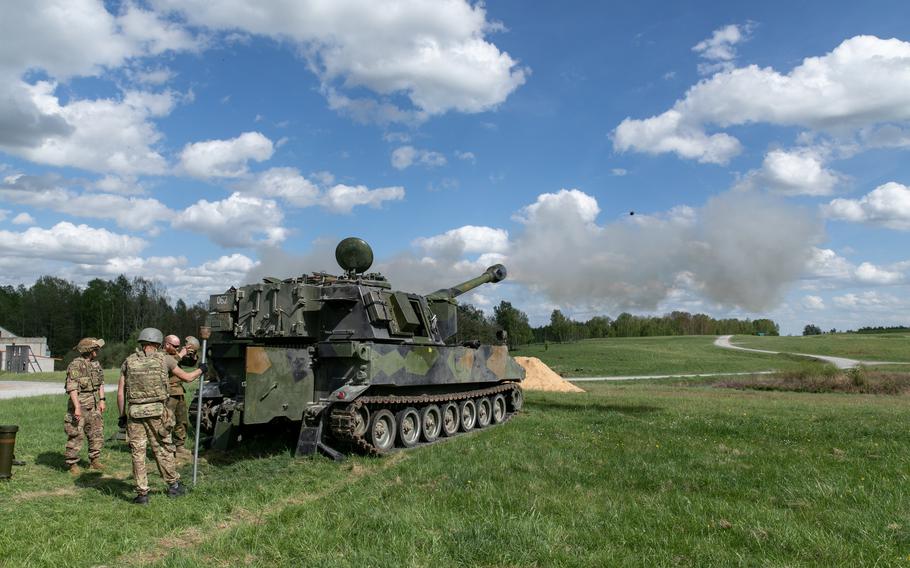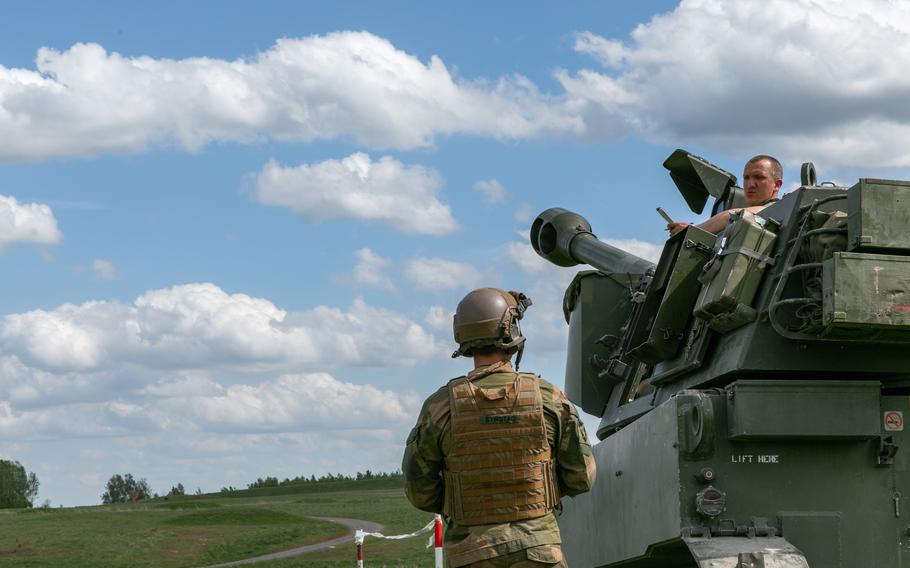
Ukrainian artillerymen fire the M109 self-propelled howitzer during training at Grafenwoehr Training Area, Germany, May 12, 2022. Soldiers from the U.S. and Norway trained Ukrainian artillerymen amid Ukraine's ongoing defense of its country against Russia's invasion. (Spencer Rhodes/U.S. Army)
KAISERSLAUTERN, Germany — The U.S. Army in Germany didn’t quite train Ukrainians on artillery up to American military standards, but that’s mostly because the seasoned Ukrainian soldiers they worked with had a war to get back to fighting.
The Army adequately taught Ukrainian troops how to use High Mobility Artillery Rocket Systems, howitzers and other hardware that is part of roughly $40 billion in U.S. security assistance given to Ukraine since Russia’s invasion last February, the Defense Department Inspector General said.
The 7th Army Training Command developed more than two dozen operating and maintenance programs, which it offered to Ukrainians at sites in Germany between April and December last year.
“Based on our analysis of the training provided and platforms approved for transfer to Ukraine, we did not identify any instance when the 7th ATC did not provide (Ukraine)-requested operational or maintenance training,” the IG said in a report released Thursday.
“We did not identify any critical gaps in [the] training,” the report added.

A Norwegian soldier instructs a Ukrainian artilleryman training on the M109 self-propelled howitzer at the U.S. Army's Grafenwoehr Training Area, Germany, May 12, 2022. A Defense Department Inspector General report recently assessed the training provided to Ukrainian troops as adequate to meet mission demands. (Sgt. Spencer Rhodes/U.S. Army)
Officials with the 7th ATC said they didn’t train the Ukrainian troops “to U.S. Army standards or doctrine” because the Ukrainians weren’t in Germany long enough to do so.
For example, advanced individual training for a howitzer cannon crew member in the U.S. lasts seven weeks, while the instruction given to the Ukrainians was said to be just six days.
An unnamed Ukrainian official mentioned in the report said the short duration was sufficient, as most of the trainees were experienced fighters who only required familiarization with the systems.
The 7th ATC said their programs focused on critical tasks and skills needed to maintain and operate the systems so that the troops could return quickly to the battlefield.
Other platforms included Stinger shoulder-mounted rocket launchers, Q-64 Sentinel radar, Puma aerial drones and precision-guided munitions.
The training was given at the Grafenwoehr Training Area and Hohenfels Army Barracks in Bavaria. The type of training, total classes provided and number of trainees were redacted in the report.
The most significant challenge to the Army’s training programs was said to be the lack of manuals and other materials translated into Ukrainian.
However, as of January — a month after the period the report examines — material for 15 of the 17 platforms had been translated. The Ukrainians did not request materials for the remaining two for reasons that weren’t specified.
The IG said it had no recommendations following the audit but would continue to examine the Defense Department’s training.
In a separate report released June 12, the IG found that military personnel struggled to account properly for some of the U.S.’s security assistance to Ukraine, including howitzers and night vision goggles, but noted there was no evidence of theft or loss.
The audits come as the U.S. on Tuesday announced a new $325 million military aid package for Ukraine that will include munitions for air defense systems, ammunition and vehicles, as Ukraine begins its counteroffensive against invading Russian forces.